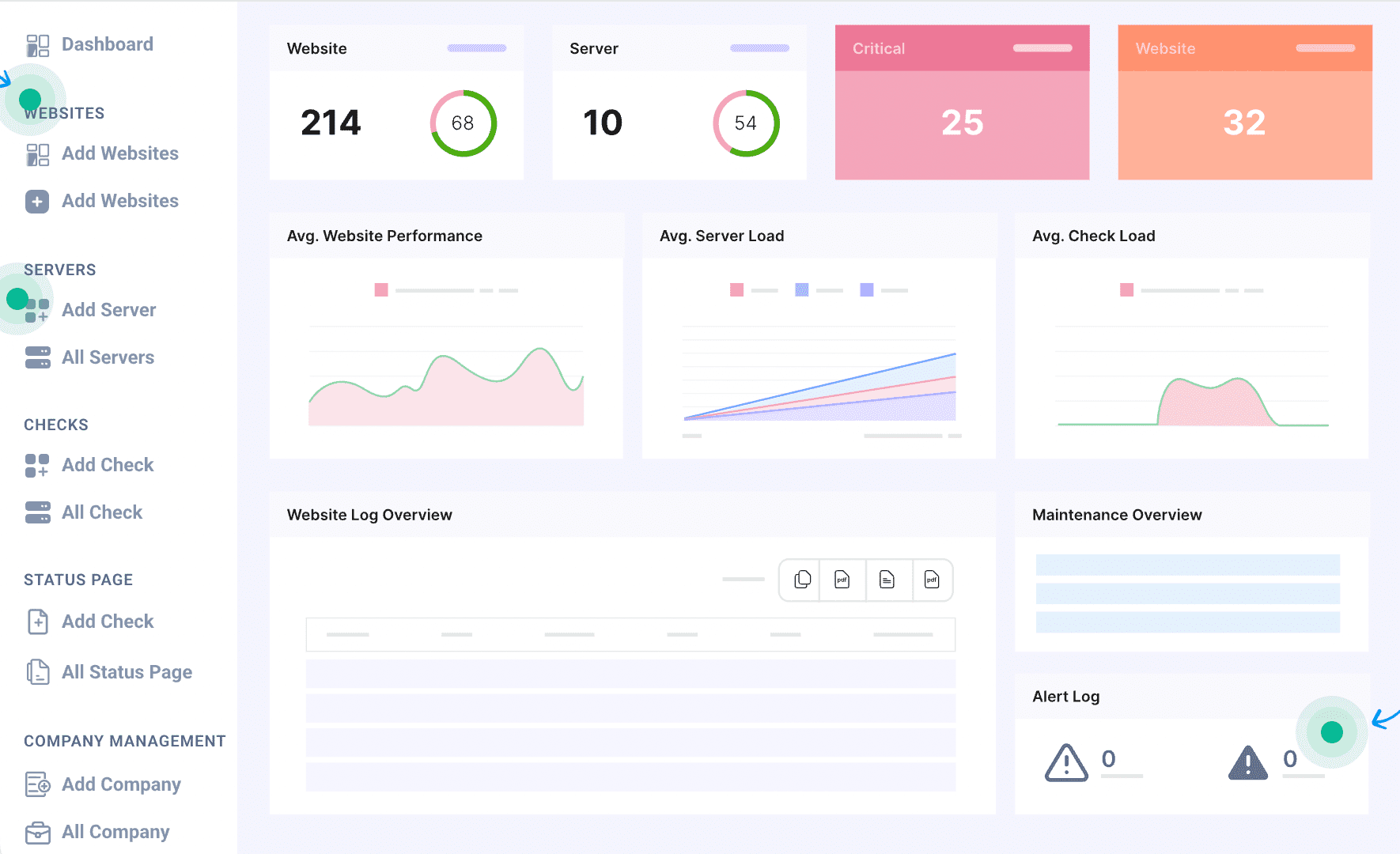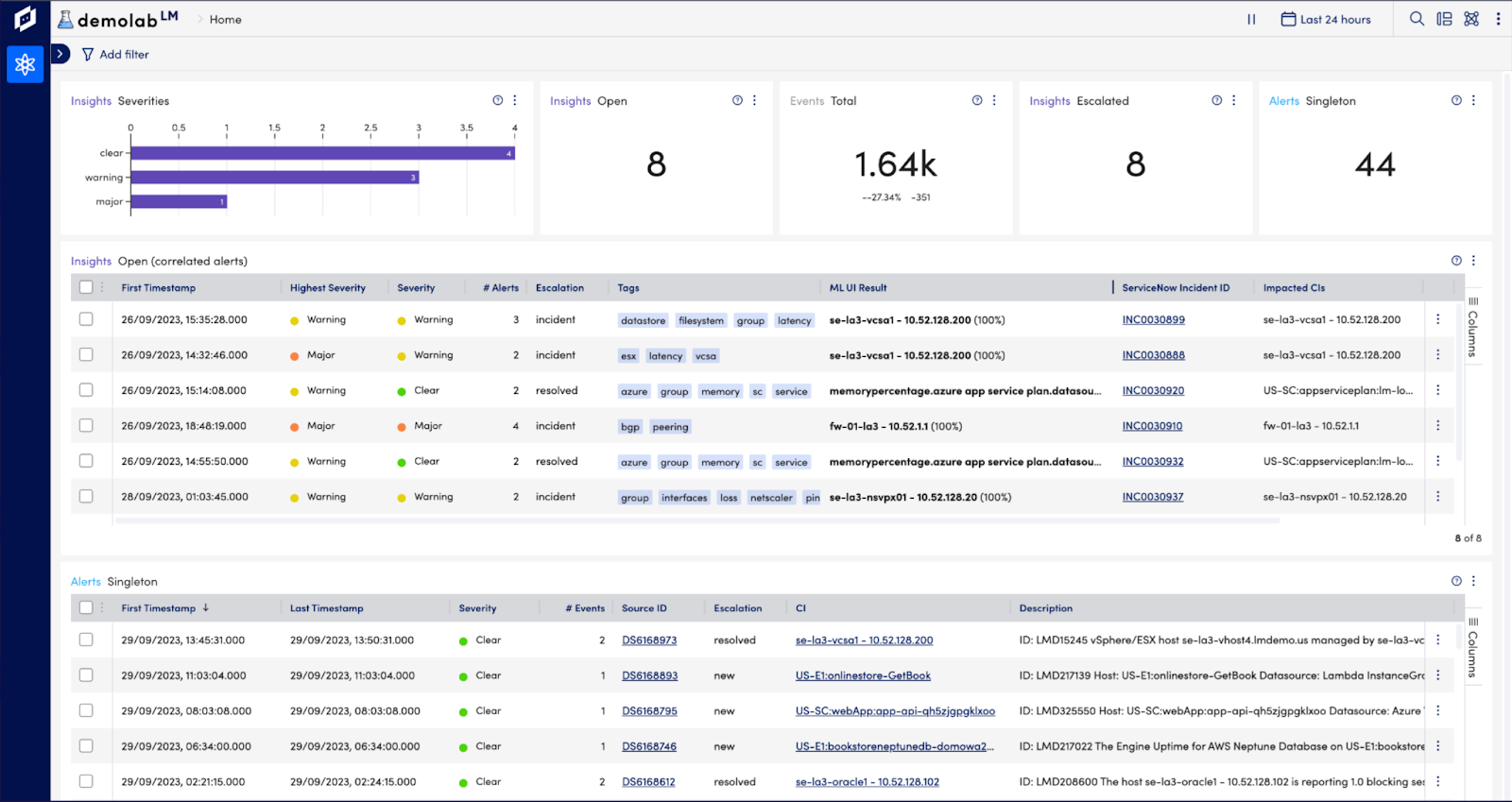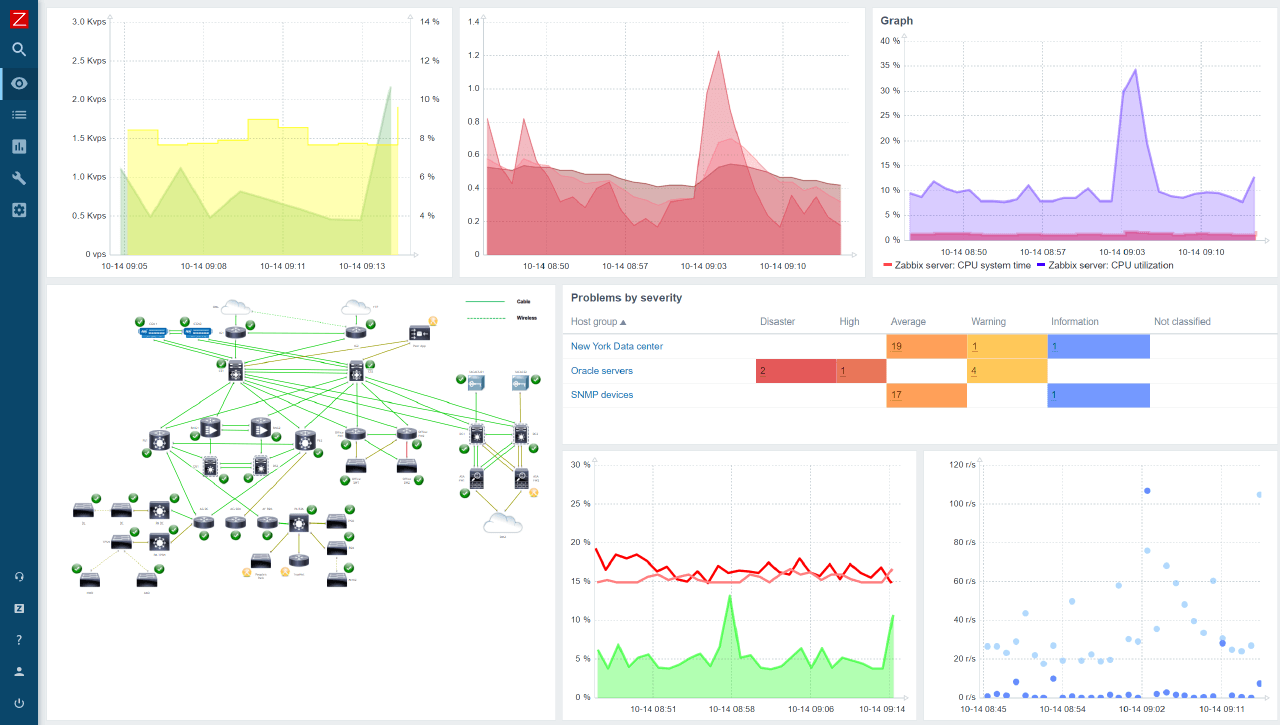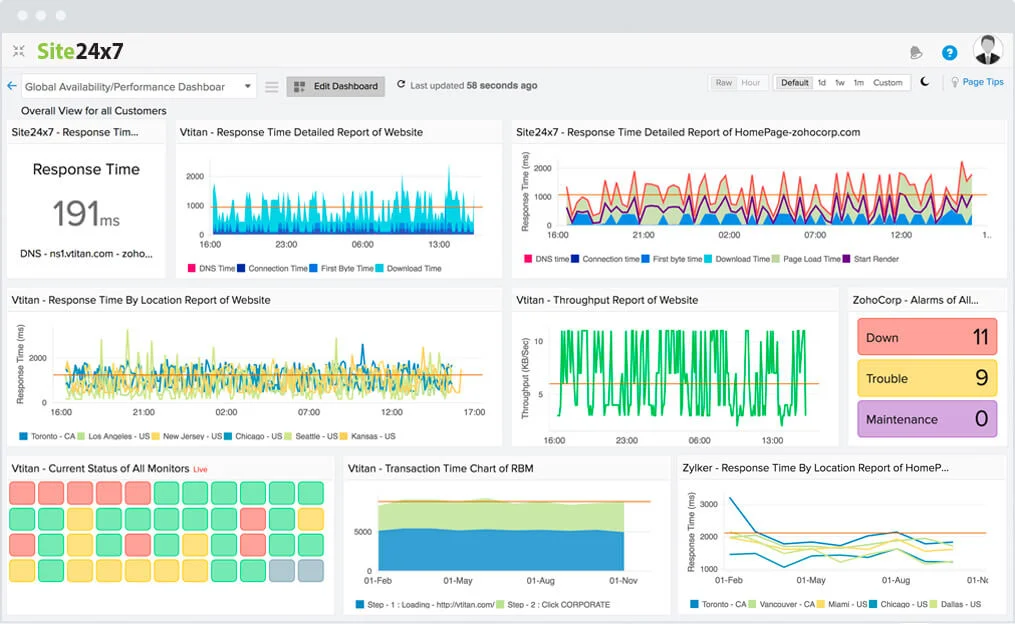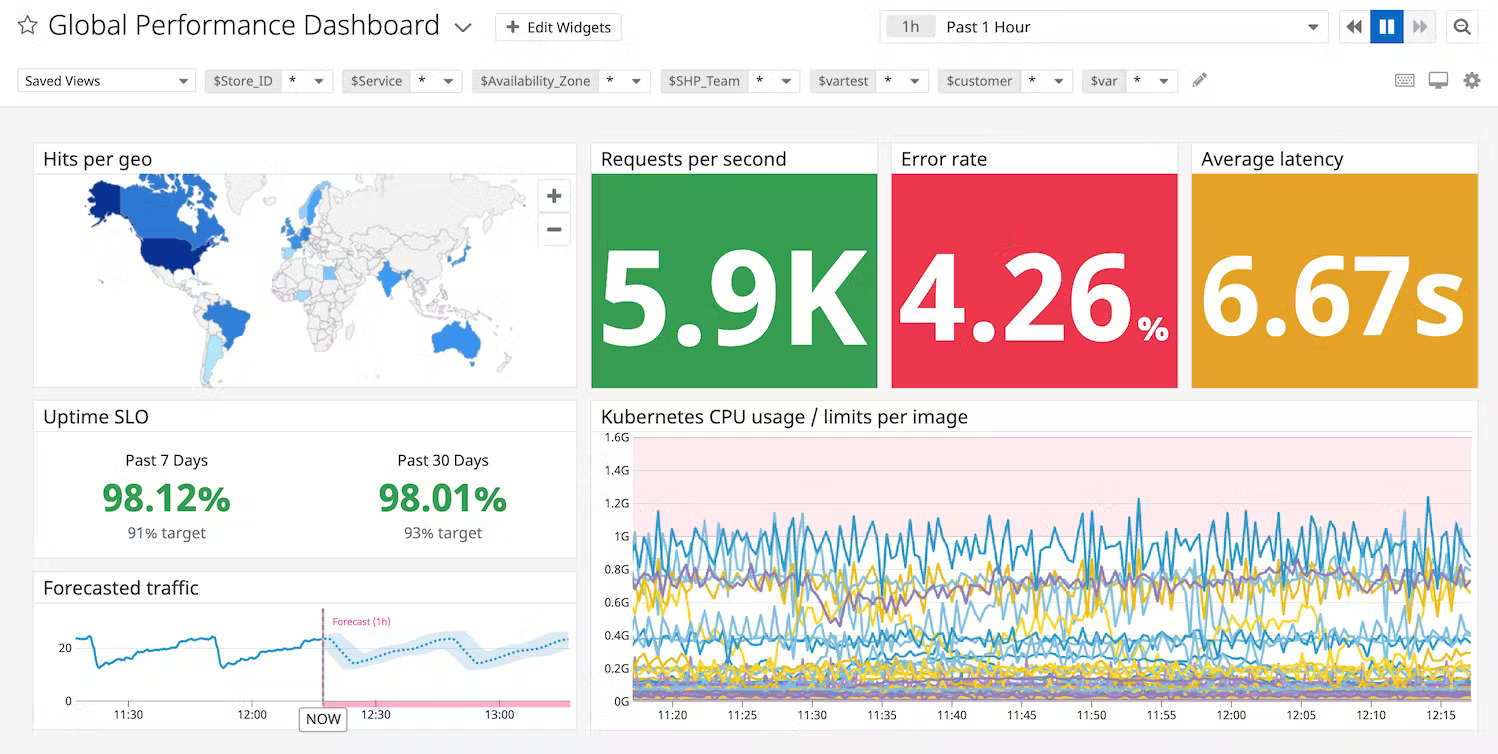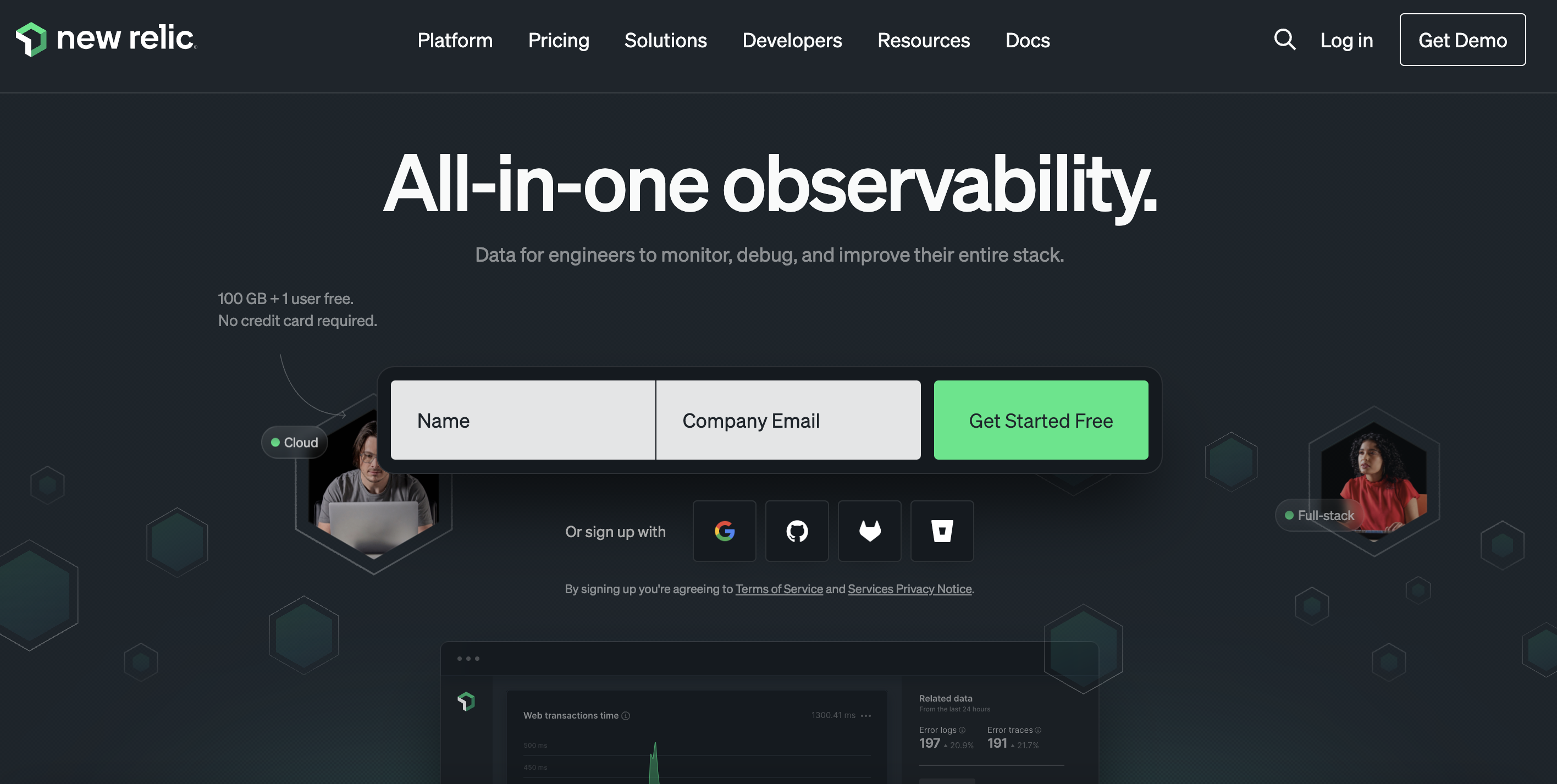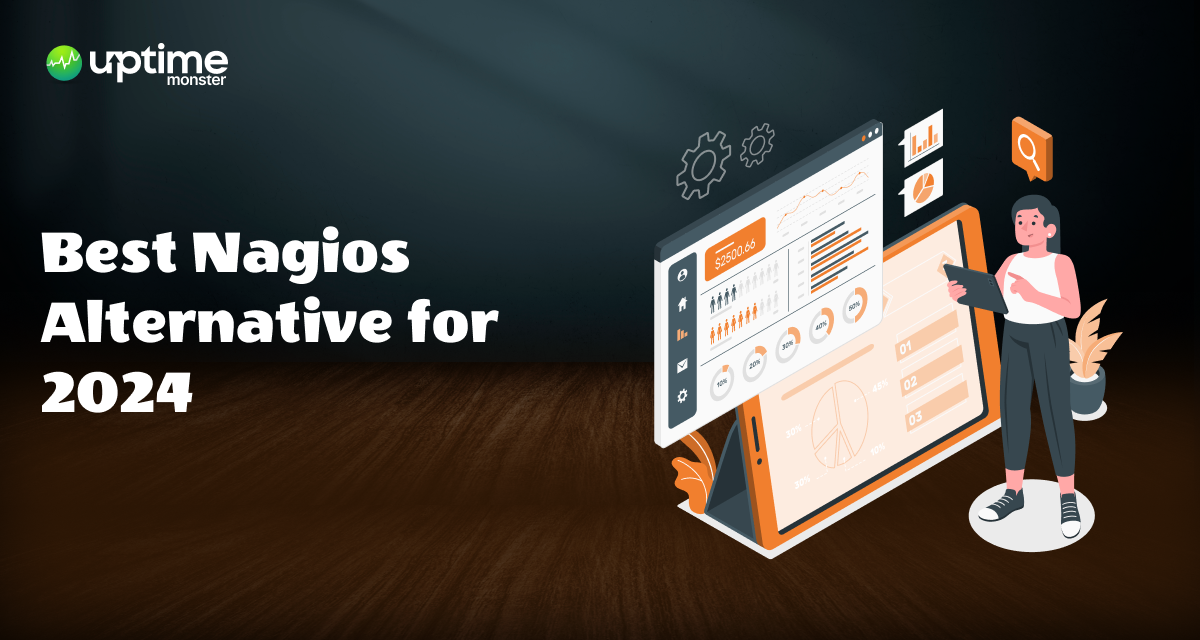
12 Best Nagios Alternative in 2024
Are you looking for the best Nagios Alternative for 2024?
What is Nagios?
Nagios is an open-source and commercial monitoring tool used by businesses of all sizes to keep their IT infrastructure up and running. It monitors everything from servers and networks to applications and services, alerting you to potential problems before they become critical.
Nagios XI diligently monitors various elements of your infrastructure, encompassing applications, operating systems, network architecture, network protocols, services, and system metrics. Its extensive library of hundreds of third-party addons empowers you to monitor virtually any internal or external program, service, or system with flexibility and adaptability.
Nagios Fusion unites dispersed Nagios XI and Core servers, granting panoramic network oversight and simplifying issue resolution across vast networks. Centralize diverse Nagios deployments with Fusion, boosting scalability and resolving geographically scattered network issues effortlessly.
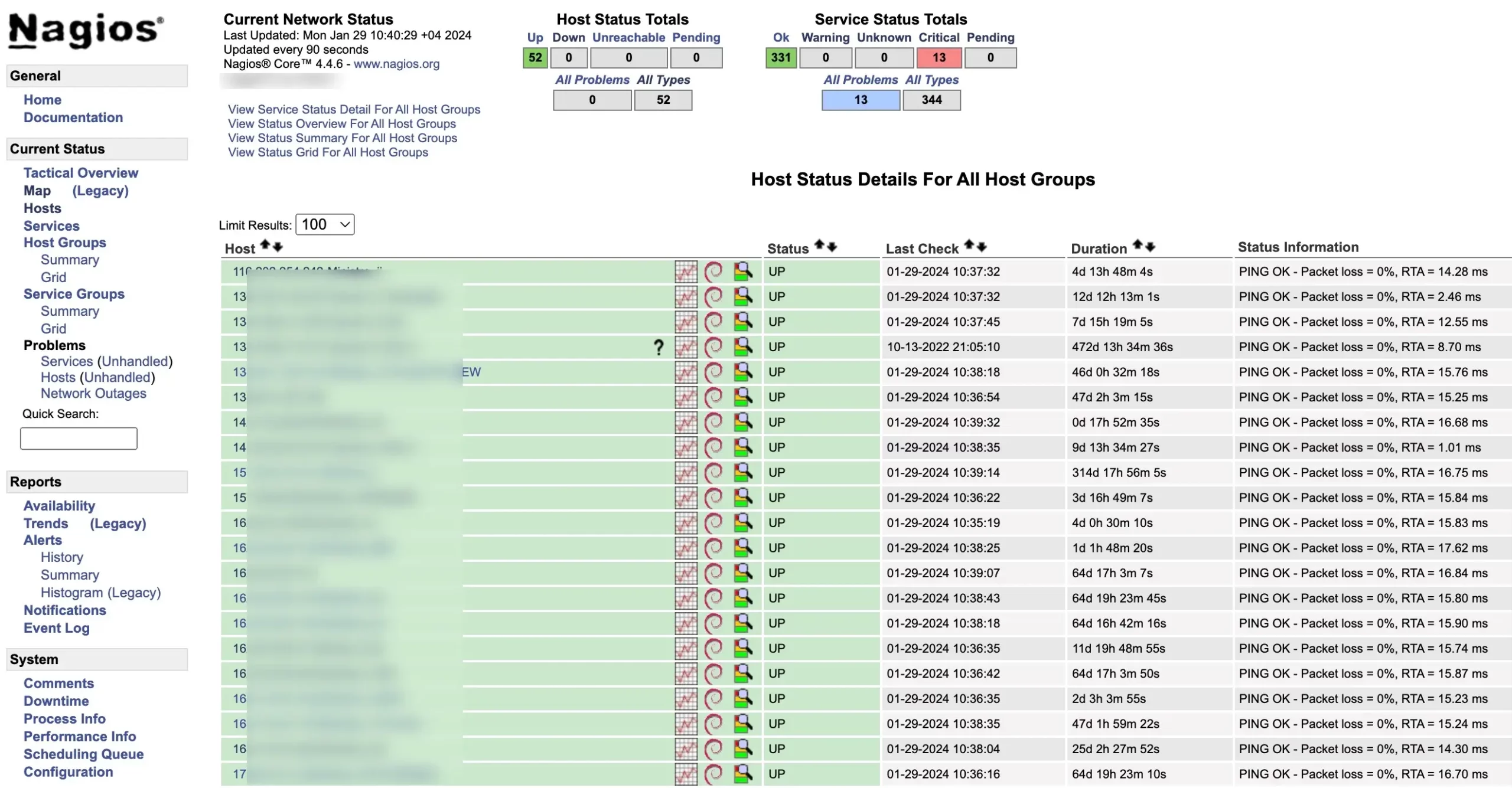
Cons
- Can be complex to set up: Nagios can be complex to set up for beginners, especially the open-source version.
- Requires technical expertise: Using and maintaining Nagios effectively requires some technical expertise.
- Limited scalability for large enterprises: The open-source version of Nagios may not be scalable enough for large enterprises.
- Potential resource intensive: Depending on your setup and workload, Nagios can be resource intensive, particularly on older hardware.
- Limited mobile functionality: The mobile app for Nagios XI offers a more limited experience compared to the web interface.
Best Alternative for Nagios
UptimeMonster
Reliable website and server monitoring service from the cloud to monitor your web availability, performance, and security. The tool will give you a 24/7 website monitoring service that will Monitor the availability of your website, APIs, and business-critical web transactions with powerful synthetic monitoring and testing tools.
It collects, correlates, and monitors servers alongside data from the rest of your stack. UptimeMonster server monitoring allows you to visualize, analyze, and track down different query metrics happening on your server so that you can prevent them before anything goes wrong.
Monitor your network performance like IP, DNS, Service port, Application, and others using the check monitoring tools. It will enable you to understand the network behavior and track NetFlow.
UptimeMonster check monitoring service will give you full control over your network. The check monitoring types are as follows
- TCP (Transmission Control Protocol)
- ICMP PING (Internet Control Message Protocol)
- IP Blacklist
- UDP (User Datagram Protocol)
- DNS (Domain Name Server)
- Application Monitoring
With a status page, you can share your monitoring activities and incidents with customers. You can easily make our status page public or private. You can highly customize your status page and share it with your customers to reduce the number of customer support tickets.
Using the status page you can easily gain trust from your customers. The alert notification easily notifies your customers about any incidents so that they can take necessary steps to prevent the issue. So that they will always be prepared and stay tuned.
Create and customize intricate policies for the escalation of incidents by taking into consideration various factors, including the passage of time, the availability of your team, and the source or origin of the incident.
Key Features
- Reliable Website and Server Monitoring
- Network Performance Monitoring
- Check Monitoring Types
- Status Page Customization
- Alert Notifications
- Incident Escalation Policies
- Incident Timeline
- SSL Expiration Monitoring
- Search String Monitoring.
Pros
- Reliable Uptime Monitoring
- Easy Setup and Configuration:
- Cost-Efficiency
- Customer Support:
- Accurate Reporting:
- User-Friendly Interface
- Customizable Alerts
- Status Page
- Escalation policies
- Incident Timeline Report
Cons
According to user reviews, UptimeMonster doesn’t exhibit any notable drawbacks. However, a few users have highlighted certain feature limitations present in the free plan offering. These limitations might include restricted access to certain functionalities or reduced capabilities compared to the premium plans. Despite this, the overall consensus from users is overwhelmingly positive regarding the platform’s performance and functionality.
Our perspective on this matter revolves around the notion that smaller teams might not necessitate the utilization of numerous advanced features. Therefore, it appears reasonable to curtail access to certain functionalities, considering that smaller teams might not require or fully utilize these advanced features. This approach ensures a streamlined and more focused user experience, optimizing the platform’s usability for smaller teams with specific needs.
Pricing
- Standard plan at $7/month with 30 monitors and 2-minute interval
- Professional plan at $19/month with 50 monitors and 1-minute interval
- Business plan at $99/month with 100 monitors and 25-second interval
LogicMonitor
LogicMonitor presents an expansive solution, delivering log intelligence at a scale specifically tailored for hybrid and multi-cloud environments. The platform excels in centralizing, correlating, and contextualizing data, prioritizing data hygiene and internal compliance to ensure a comprehensive and compliant log management experience.
One notable feature of LogicMonitor is its capability to centralize monitoring activities, enabling users to seamlessly correlate pertinent logs with metrics within a singular platform. This integrated approach enhances the overall coherence of monitoring efforts, fostering a more holistic understanding of system performance.
Pros
- Wide range of vendor equipment supported
- Modules can be customized
- Agent or agentless monitoring
- Security features
Cons
- Changing the alerting settings is difficult
- No prebuilt alerts and templates are provided
- Customization Complexity
- Expensive
- Doesn’t provide any detailed reporting
- Mobile app not user-friendly
Pricing
- The initial price starts at $15 per device per month, the price may vary based on configurations and requirements
Zabbix
Zabbix is a powerful, enterprise-grade monitoring solution that keeps a watchful eye on your IT infrastructure, ensuring everything runs smoothly and efficiently. Whether you’re a small business or a large organization, Zabbix provides comprehensive monitoring capabilities to safeguard your critical systems and applications.
Utilizing an extensive range of data collection methods, including JMX, SNMP, WMI, IPMI, and customizable scripts, this software provides a precision-focused approach to network monitoring. It can adapt diverse monitoring requirements, whether in on-premise or cloud environments, catering to networks of varying complexities.
Key Features
- Trend Prediction: Anticipate future trends with Zabbix’s trend prediction feature, enabling proactive measures based on historical performance data.
- Automated Problem Resolution: Zabbix streamlines operations with automated problem resolution, minimizing manual intervention and ensuring swift responses to detected issues.
- Anomaly Detection: Uncover irregularities in your network’s behavior using Zabbix’s anomaly detection, providing early insights into potential performance deviations.
- High-Level Map Navigation: Gain a comprehensive understanding of network structure and dependencies through Zabbix’s high-level view with map navigation, offering a visual representation of your network landscape.
Zabbix seamlessly integrates with a diverse array of IT infrastructure components, fostering compatibility and interoperability:
- Database Harmony: Collaborate effortlessly with databases, as Zabbix aligns smoothly with MySQL, PostgreSQL, and Oracle, ensuring seamless data synchronization.
- Cloud Compatibility: Embrace cloud services without constraints—Zabbix extends its capabilities to work seamlessly with cloud giants such as AWS and Azure, providing holistic cloud monitoring.
- Interconnectivity with Monitoring Tools: Forge connections with other monitoring tools effortlessly, as Zabbix harmonizes with popular solutions like Grafana and Elasticsearch, offering a unified and synergized monitoring ecosystem.
Pros
- Versatile Data Collection Methods
- Scalable to Large Networks
- Open-Source and Cost-Effective
Cons
- Steeper Learning Curve
- GUI Could Be More Intuitive
- Requires In-House Expertise for Setup and Maintenance
Pricing
- Zabbix Core: Free and open-source, ideal for individuals, small businesses, and non-profit organizations.
- Zabbix Enterprise: Paid version with additional features like enhanced security, distributed monitoring, and high availability. Pricing depends on the number of monitored items and licenses.
- Zabbix Professional Support: Optional paid support plans for Zabbix Core and Zabbix Enterprise, offering faster response times, technical expertise, and access to exclusive resources.
iCINGA
Icinga, an open-source network monitoring tool, delivers adaptable and scalable solutions for monitoring network resources, notifying users of outages, and supplying data for reporting purposes. Renowned for its extensible architecture, Icinga is an ideal choice for environments seeking a monitoring solution that is both customizable and scalable to their specific needs.
Its capability to seamlessly adapt to the expansion of an organization’s network and its capacity to integrate with a plethora of plugins and add-ons for enhanced functionality showcase its versatility.
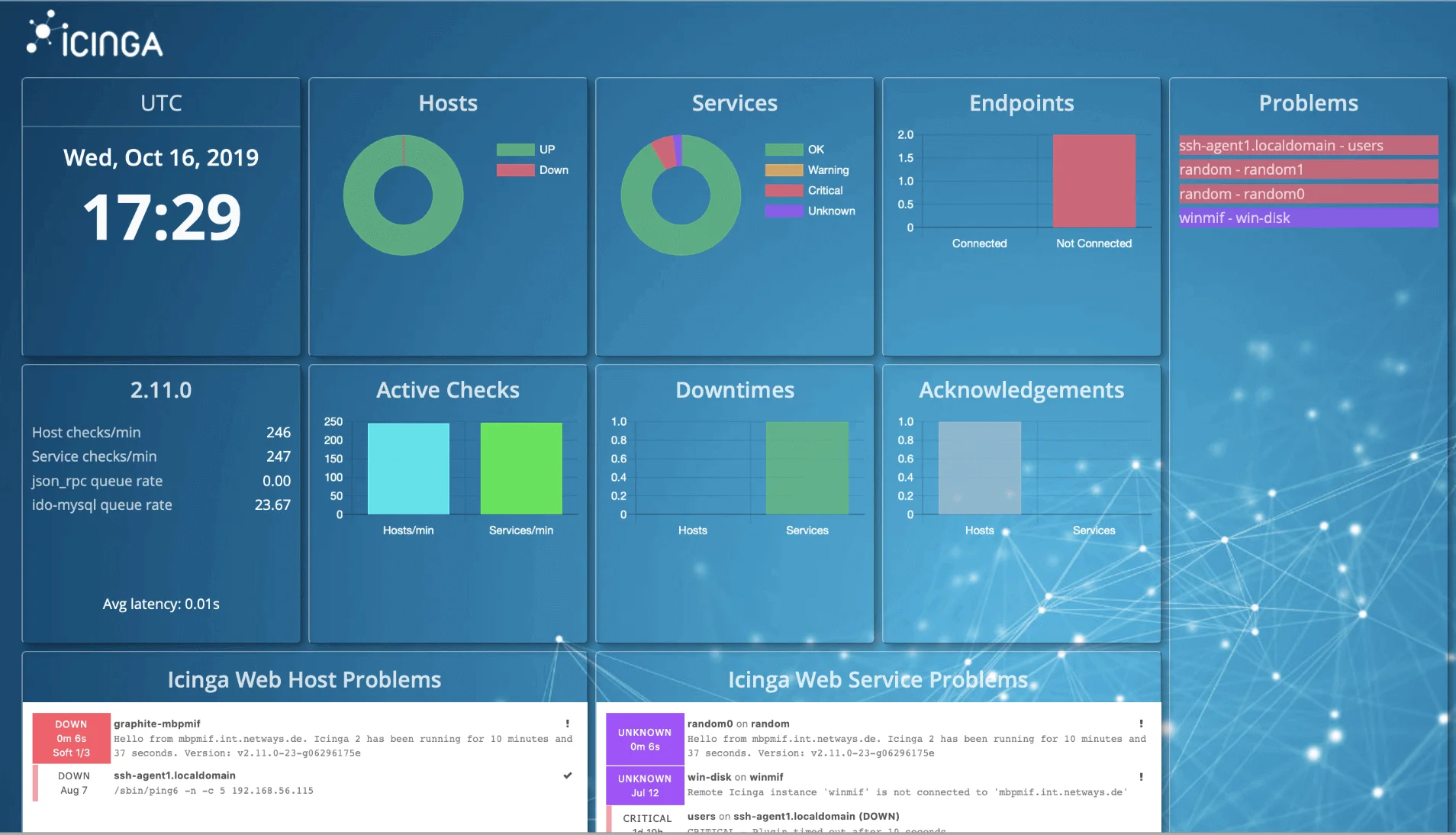
Key Features
- Real-Time Network Monitoring: Icinga excels in real-time network monitoring, providing instant insights into the health and performance of critical network resources.
- Multi-Channel Notifications: Stay informed with notifications delivered through various channels, ensuring prompt alerts for any detected issues, and allowing for quick response and resolution.
- Customizable Reporting: Tailor your reporting to meet specific needs with Icinga’s customizable reporting capabilities, providing in-depth insights into network performance and trends.
- Web Interface for Management: With a user-friendly web interface, managing and visualizing network data becomes a seamless process, enhancing overall ease of use and accessibility.
- Integration with Graphite: Icinga seamlessly integrates with Graphite for efficient metrics storage and visualization, enhancing the analytical capabilities of network monitoring.
- Puppet Integration for Automation: Strengthen your network monitoring capabilities with integrations like Puppet for IT automation, enabling automated responses to identified issues and streamlining operational workflows.
Pros
- Open-source and Cost-effective
- Highly Flexible and Customizable
- Alerting and Reporting:
- Active Community and Support
- Lightweight and Scalable
Cons
- Initial Setup Complexity
- Documentation could be improved
- Interface can feel outdated
Pricing
As an open-source tool, Icinga is freely available for use. Besides, if your needs extend to enterprise-level features and dedicated support, Icinga provides commercial packages, and details regarding their pricing can be acquired through inquiry.
Atera
Atera is a cloud-based platform that brings together a comprehensive suite of IT management tools under one roof. It caters specifically to Managed Service Providers (MSPs) and internal IT teams, aiming to streamline operations, boost efficiency, and deliver exceptional customer service.
This cloud-based solution offers a unified suite of tools for remote monitoring and management (RMM), professional services automation (PSA), and remote access. Atera streamlines IT workflows, providing real-time insights into network performance, security, and device health. With features like automated ticketing, patch management, and remote support, Atera empowers IT professionals to efficiently manage and optimize their clients’ systems, ensuring proactive and responsive services.
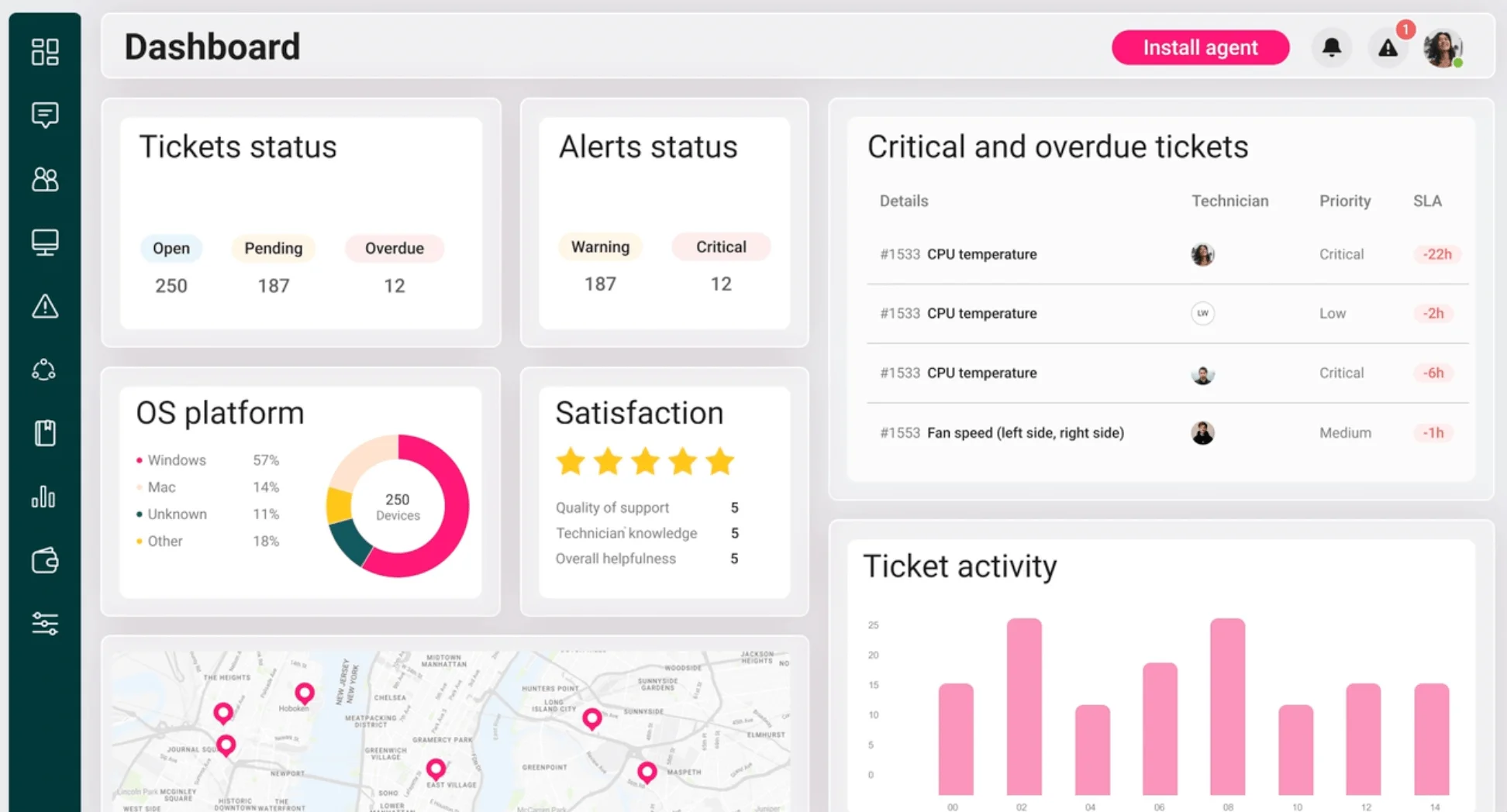
Key Features
- Remote Monitoring and Management (RMM)
- Professional Services Automation (PSA)
- Remote Access
- Network Monitoring
- Automated Ticketing
- Patch Management
- Proactive Alerts and Notifications
- Backup and Recovery
Pros
- Multi-tenanted architecture for versatile usage
- Empowers each support technician to manage multiple clients efficiently
- Incorporates automated patch management for streamlined updates
- Features remote access and remote desktop utilities for enhanced accessibility
Cons
- Mobile app functionality is not as robust as the web version
- Occasional delays in ticket notifications
- The difficult learning curve for beginner
- Network topology mapping requires an additional cost.
Pricing
- The Basic plan starts at $149/ month
- The Expert plan starts at $169/ month
- The Master plan starts at $199/ month
Paessler PRTG Network Monitoring
PRTG network monitoring solution is designed to track network up/down status, traffic, and usage. Key features encompass availability, performance, and bandwidth monitoring through SNMP, WMI, packet sniffing, and NetFlow. Instant alerts, comprehensive reporting, and failover clustering are included.
PRTG Network Monitor operates as an agentless solution, eliminating the need for agent installations on target devices and applications. Instead, it utilizes network protocols like SNMP, WMI, NetFlow, or SSH for efficient and swift monitoring. This approach reduces the burden and ensures a seamless monitoring experience.
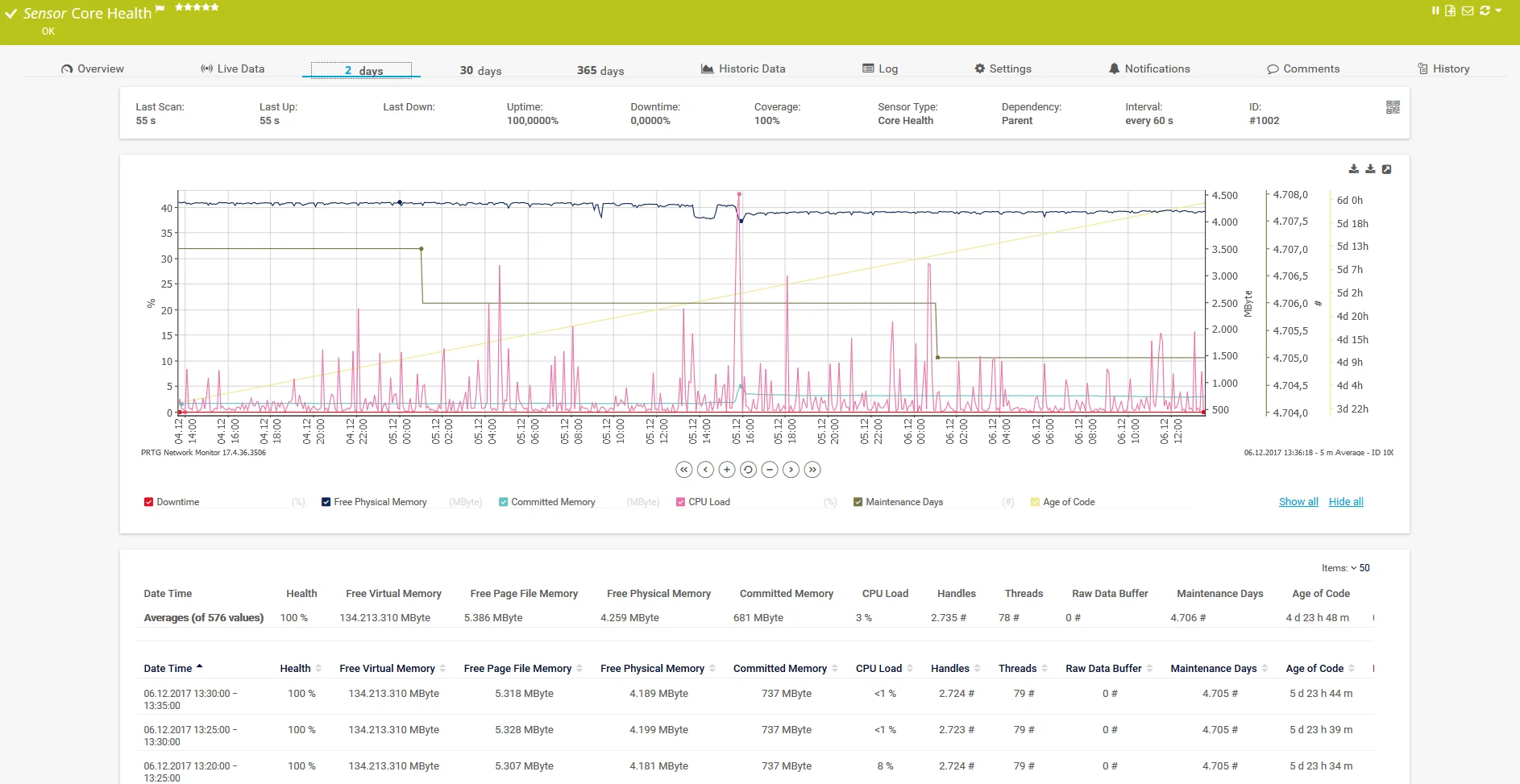
Key Features
- In-depth Reporting
- Maps and Dashboards
- Flexible Alerting
- Distributed Monitoring
- Cluster Failover Solution
- Multiple User Interfaces
Pros
- Agentless Monitoring
- Varied Network Protocols
- Customizable package
- Traffic management and comprehensive monitoring of network devices.
- Enables full-stack monitoring for a holistic view of the system.
Cons
- No patch manager
- Limited historical data in the free version
- It’s Windows base especially so managing too many Linux machines causes issues
- Licensing can be tricky as it is not based on devices but rather on sensors. Currently, each sensor, such as an interface, is counted as a sensor license.
- Maps are difficult to make
Site24x7
Site24x7 is a comprehensive website monitoring solution designed to ensure the optimal performance and availability of websites, servers, applications, and networks. The platform delivers automated network discovery and inventory management, coupled with the automatic generation of a network topology map.
It extends its monitoring capabilities across multiple sites and internet connections, including tracking the performance of web applications and websites.
Encompassing all IT assets, the Site24x7 system ensures complete stack observability. This facilitates instant root cause analysis in the event of any issues. For instance, if there’s a slowdown in application delivery, immediate insights will reveal whether it’s a network-related problem. Notifications about network device issues are promptly relayed, aiding proactive issue resolution.
Key Features
- Website Monitoring
- Server Monitoring
- Synthetic Web Transaction Monitoring
- Application Performance Monitoring
- Network Monitoring
- Public and Private Cloud Monitoring
- Real User Monitoring | RUM
- Cloud Cost Management
- Public Status Pages
- RMM for MSPs and CSPs
- Log Management from the Cloud
Pros
- Monitor Web applications and websites effectively.
- Track the performance of systems hosted both on-premises and in the cloud
- Full stack observability ensures immediate identification of root causes
- Ease of Use
- Integration Capabilities
Cons
- The setup of the Realtime user monitor was not as functional as expected about adding 3rd party scripts.
- Takes a long time to set up everything for monitoring
- Occasional False Positives
- Costly
Pricing
- Pro plan at $35 with 40 monitors
- Classic plan at $89 with 100 monitors
DataDog
Datadog’s website monitoring stands out as a comprehensive solution that offers unparalleled visibility. It goes beyond mere aggregation by seamlessly collecting metrics and events from an extensive range of over 500 integrated technologies, tagging and storing them for further analysis.
Notably, Datadog streamlines the entire process by taking care of the ingestion, normalization, and enrichment of logs, allowing users to focus on deriving meaningful insights rather than grappling with technical intricacies. This ensures a user-friendly experience and maximizes the efficiency of log management operations.
Furthermore, Datadog doesn’t stop at threat identification; it actively tracks the performance impact of every deployed code. This automated tracking extends to mapping data flows and dependencies through a service map, offering a visual representation of the intricate relationships within the infrastructure. By doing so, Datadog not only ensures robust security but also provides valuable insights into the operational dynamics of the entire system.
Pros
- Real-time log tracking
- Security monitoring
- Integrations
- Alerting system
- Custom downtime for deployment
Cons
- The primary weakness of Datadog lies in its scaling capabilities. Increasing metrics monitoring necessitates additional monitors, significantly impacting monthly billing and leading to high expenses.
- Datadog’s complexity might pose challenges, particularly for users unfamiliar with monitoring systems. Navigating and finding specific functionalities can be challenging without prior experience.
- Immediate action is lacking when decommissioning a host. It takes up to 24 hours for a host to be officially removed from the list, causing delays in real-time updates upon decommissioning.
- The basic plugins in Datadog offer limited information. Users often need to configure their plugins to obtain more detailed reports, adding complexity to data retrieval.
- Graphical reports in Datadog are not intuitively comprehensive, failing to provide easily understandable and valuable information to users.
Pricing
- Pro package at $15 per host/per month
- Enterprise package at $23 per host/per month
ManageEngine OpManager
ManageEngine OpManager is a powerful network monitoring software that provides deep visibility into the performance of your routers, switches, firewalls, load balancers, wireless LAN controllers, servers, VMs, printers, and storage devices. It is an easy-to-use and affordable network monitoring solution that allows you to drill down to the root cause of an issue and eliminate it.
Featuring flexible per-device pricing, OpManager enables gradual scalability beyond the Free Edition’s foundational features. Its compatibility with various operating systems and hypervisors makes it an excellent choice for managing virtual infrastructure, aligning seamlessly with your company’s long-term objectives.
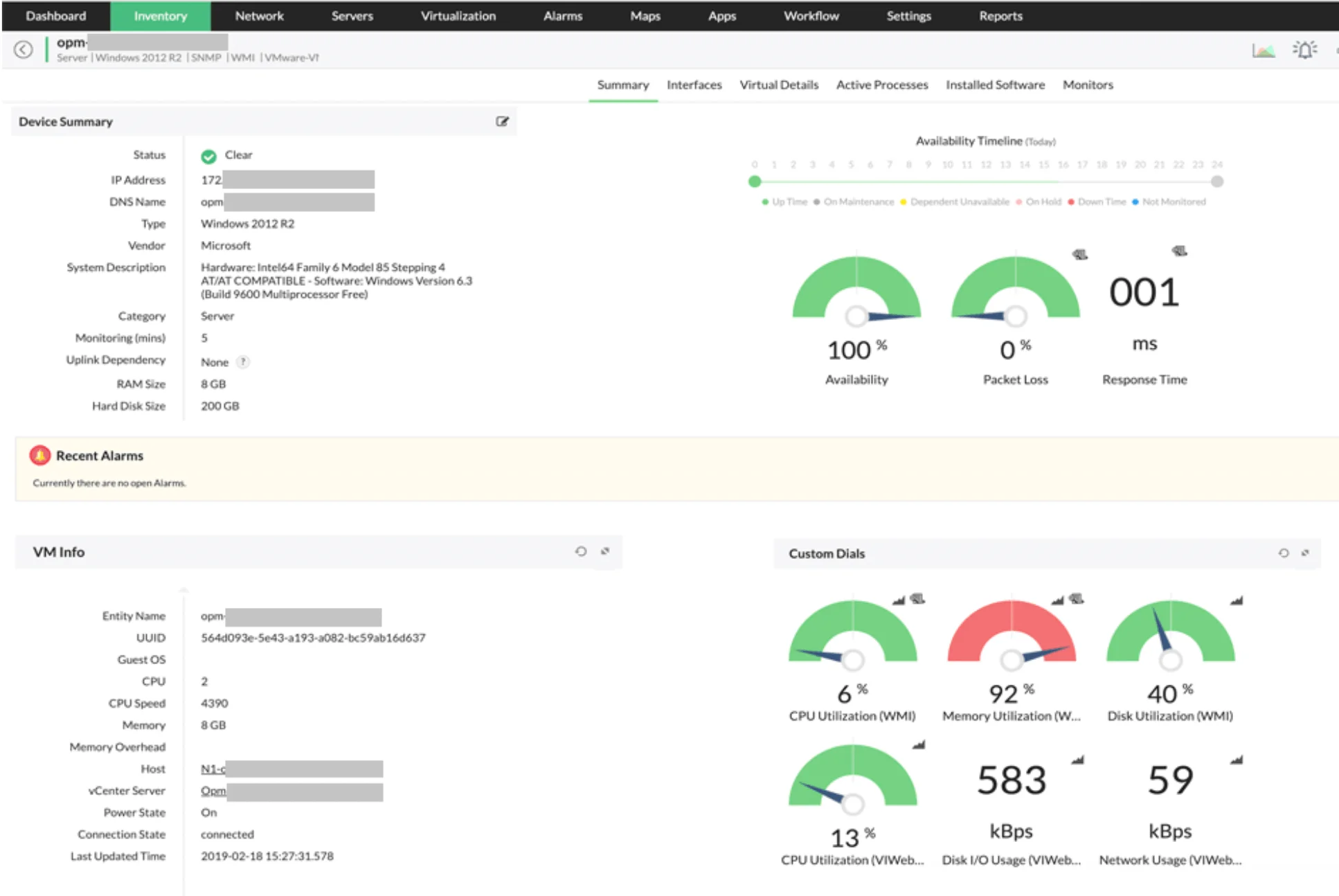
Key Features
- Comprehensive Network Monitoring
- Proactive Issue Resolution
- Flexible Per-Device Pricing
- Compatibility and Virtual Infrastructure Management
- End-to-End Visibility and Analytics
- Sophisticated Autodiscovery Tools
- Integration Capabilities
Pros
- Easy to use
- Affordable
- Scalable
Cons
- Limited free edition
- Some advanced features require additional licenses
- Can be resource-intensive for large networks
Pricing
ManageEngine OpManager offers a variety of pricing plans based on the number of devices you need to monitor. The Standard Edition starts at $245 per year for 10 devices, the Professional Edition starts at $345 per year for 10 devices, and the Enterprise Edition starts at $11,545 per year for 250 devices.
Zenoss
Zenoss is a unified monitoring platform that helps businesses of all sizes gain visibility and control over their IT infrastructure. It goes beyond simple monitoring, offering intelligent event correlation, automation, and remediation capabilities to keep your systems running smoothly.
Its remarkable scalability and holistic monitoring approach distinguish it from the rest. In my evaluation, Zenoss stands out as the “Top Choice for unified monitoring in large-scale environments,” thanks to its broad infrastructure coverage and the depth of its monitoring capabilities.
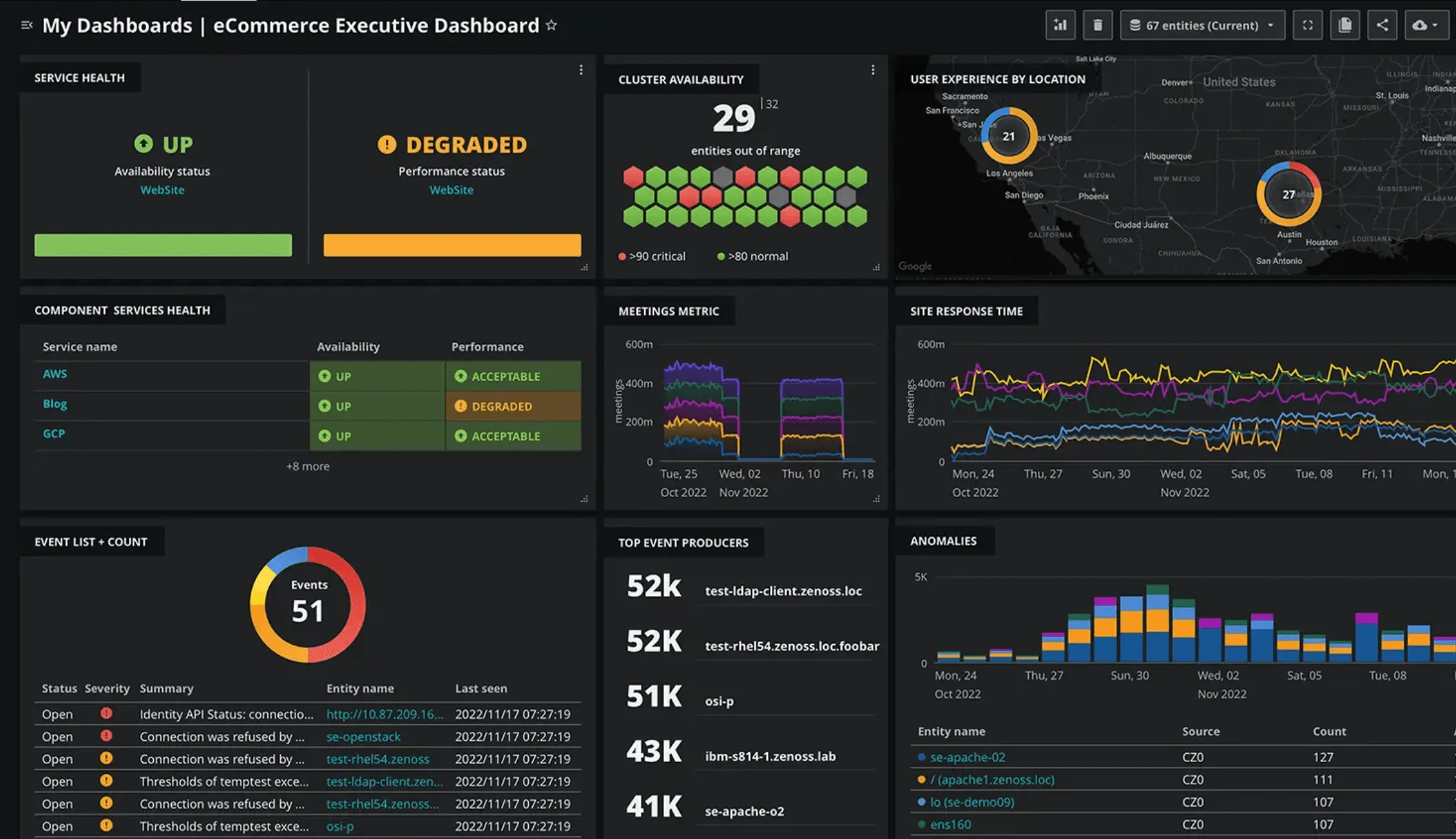
Key Features
- Real-Time Analytics: Zenoss incorporates real-time analytics, providing immediate insights into the performance and health of IT infrastructures. This enables timely decision-making and proactive issue resolution.
- Capacity Planning: The platform includes robust capacity planning tools, allowing organizations to efficiently manage and optimize their resources based on real-time data and analysis. This feature aids in ensuring optimal performance and resource utilization.
- Root Cause Analysis: Zenoss facilitates root cause analysis, helping IT teams identify and address the underlying issues causing disruptions or performance degradation. This feature enhances incident resolution efficiency.
- Extensive Integrations: Zenoss offers comprehensive integrations with various technologies, including public clouds such as AWS, Azure, and Google Cloud. It also seamlessly integrates with private cloud solutions and virtualization technologies like VMware and OpenStack.
- Cloud Integration: With native integration capabilities for leading public cloud providers, Zenoss enables organizations to monitor and manage their cloud-based resources effectively. This ensures a unified approach to monitoring across on-premises and cloud environments.
- Private Cloud and Virtualization Support: Zenoss extends its support to private cloud environments, ensuring seamless monitoring of resources within private infrastructures. Additionally, it integrates with virtualization technologies like VMware and OpenStack to provide holistic visibility.
Pros
- Extensive Range of Integrations
- Comprehensive Monitoring Features
- Scalable for Large-Scale Environment
- Increased visibility and control
Cons
- No Transparent Pricing Available
- Complex Setup and Configuration
- Perceived Complexity Compared to Similar Tools
Pricing
- Starter Edition: Up to 250 devices – $5,000 per year
- Standard Edition: Up to 1,000 devices – $10,000 per year
- Enterprise Edition: Unlimited devices – Contact Zenoss for a quote
Grafana
Grafana is an open-source and commercial platform that transforms raw data into captivating visuals, empowering users to understand and communicate complex information with ease. Whether you’re a developer, analyst, or business leader, Grafana offers a powerful suite of features to make sense of your data and gain actionable insights.
Grafana enables you to visualize your existing data, whether it’s sourced from your Kubernetes cluster, Raspberry Pi, various cloud services, or even Google Sheets, and present it in a customized manner on a unified dashboard.
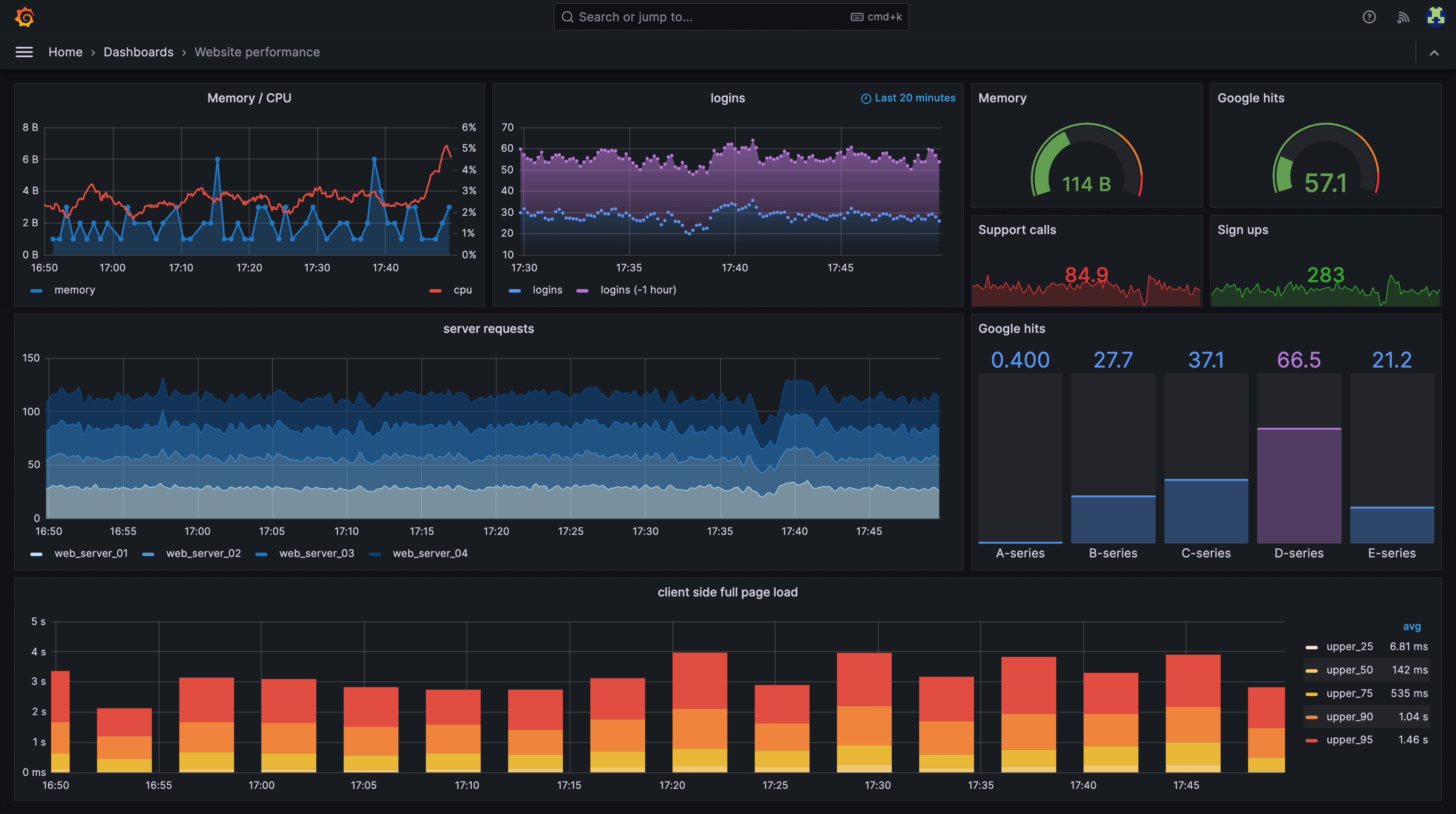
Key Features
- Dashboard templating
- Alerts
- Annotations
- Custom plugins
- Permissions
- Authentication
- Kiosk mode and playlists
- Provisioning
Pros
- Log aggregation and powerful Logql to filter and view your logs
- Microservices monitoring
- Large number of plugins and data sources to collect your metrics from almost anywhere
- Graphs and dashboards are portable
- Readability of logs
Cons
- Documentation needs to be more clarified
- Notification alert message templates need to be simplified
- Resource-Intensive
Pricing
Grafana Advanced: Starts at $299 per user per month
New Relic
With New Relic, you can get a real-time, comprehensive understanding of your network, infrastructure, applications, end-user experience, machine learning models, and beyond. You can also attain total application visibility, spanning from backend APIs to frontend devices. Whether on-premises or in the cloud, access in-depth visibility into your infrastructure within a unified platform. New Relic also offers effortless management and analysis of logs, enhancing your overall system monitoring capabilities.
Key features of New Relic
- Application Performance Monitoring (APM)
- Infrastructure Monitoring
- Synthetic Monitoring
- Error Tracking
- Full-Stack Observability
- Dashboards and Reporting
- Alerting and Notification
Pros of New Relic
- Flexible solutions
- Dynamic reporting
- Graph view of distributed tracing
- Error logging
- The agent is easy to configure and maintain.
- Integrations
Cons of New Relic
- Hard to use & help resources are slim
- Pricing is confusing
- PHP error logging misses the first line of stack traces
- No Longer data history
- Complex interface
- Alert configuration is complex
- Create False Alarms if the alert is not configured properly
Pricing
- The Data Plus option charges $0.50 per GB of data you ingest into New Relic. It costs $0.55 per GB if you choose to store your data in the EU region
- It starts at $49 per month for the Standard edition of New Relic. Pro and Enterprise editions offer custom pricing.
- New Relic offers one free full-platform user, regardless of which New Relic Edition you pick. You get one full platform user with the Standard Edition, then $99 per user after. You can add up to five users with a Standard Edition.
Wrapping Up
Each alternative offers unique features, scalability, and user-friendly interfaces, ensuring comprehensive network monitoring. Whether for simplified deployments, advanced analytics, or specific industry requirements, these alternatives provide compelling options, delivering efficient and reliable monitoring solutions beyond Nagios.
